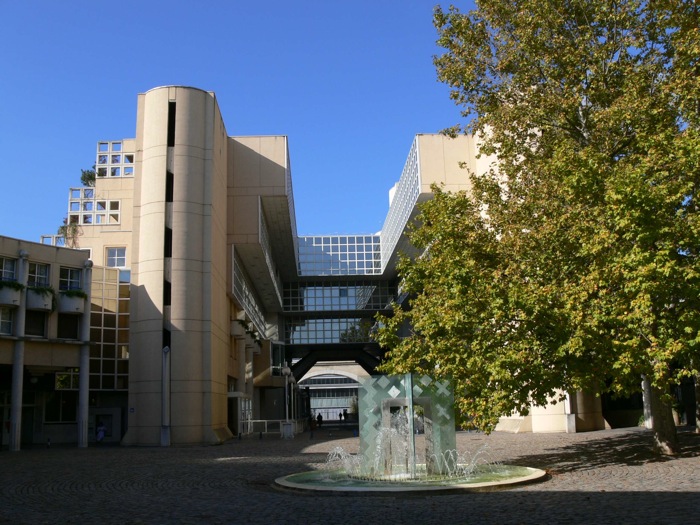Or, me voilà. Cela serait un travail énorme de trouver un appartement hors le campus de l'ENS, alors ce n'était pas une décision difficile pour moi d'habiter en résidence.
Pour deux de mes collocataires, c'est la première fois qu'ils n'habitent pas chez leurs parents. Pour Morgane, il va prendre un peu de temps pour qu'elle puisse s'habituer à habiter avec des autres étudiants (et surtout des hommes). Pour Alex, il me semble que la résidence égale la liberté ! D'une manière consciente, il invite des amis chez lui chaque jour. Il profite bien de la vie sociale. Sissoko, l'autre étudiant international, vient de Mali. Je ne le vois presque jamais alors je ne sais pas encore ce que la vie en résidence signifie pour lui.
C'est étrange de me trouver dans la même situation que ma première année où on ne se connait pas trop et nous avons besoin d'établir les systèmes pour la vie commune.
Après trois semaines, l'amie de mon colloc m'a fait remarquer que mon « lessive » de linge était par contre l'assouplissant. Voilà la raison pour laquelle mes vêtements étaient si douce mais pas vraiment propres...
Je m'habitue assez bien, mais j'ai besoin de temps en temps d'exprimer ce qui m'irrite un peu. Voilà donc ma coup de gueule contre la résidence :
1. Nous avons essayé de laver le sol à grande eau avec un balai. Je mis des chaussettes directement après être sortie de la douche, sinon mes pieds seraient toujours noirs.
2. Pour environ la première sémaine, j'ai eu des pellicules dans mes cheveux après avoir pris une douche. Il m'a pris un temps fou pour réaliser qu'il y avait un gisement de calcium sur le robinet de douche qui s'écaille sur ma tête. Dès que j'ai realisé, j'ai acheté des produits de nettoyage forts et j'ai lavé la douche ... quelle ironie !
3. Les personalités ne s'étendent pas trop bien. C'est normal et je n'ai pas attendu que tout le monde serait les meilleurs amis toute de suite, mais parfois il y a un peu de drâme que je trouve inutile. Ma philosophie personelle s'agit de ne jamais penser à des actions des autres d'une manière égoïste (don't take things personally) et j'aime croire que je suis sereine. Alors pour moi, c'est un peu décevant d'avoir besoin de servir de médiateur (dans ma deuxième langue) dans les conflits mineurs qui deviennent plus grands de ce qui est nécessaire chez nous.
4. J'ai apporté avec moi deux verres, deux assiettes, deux de chaque ustensile et deux bols. Et rien de ce dont j'ai besoin pour cuisiner. J'ai eu besoin d'acheter tout ça. J'emprunte parfois les trucs dont j'en ai besoin, mais je suis en train de collectionner les pots de compote pour que je puisse recevoir mes amis avec assez de verres. Je classifie ces pratiques comme la style de vie étudiant à l'extrême. Il me semble aussi que la plupart de mes plaintes concernent les moments où j'ai eu besoin de dépenser argent...
La plupart de mes amis internationaux ont des collocataires qui ont apporté beaucoup de trucs (ce qui est bien car les étudiants internationaux comme moi n'ont pas la capacité d'apporter n'importe quoi), mais chez nous, on a deux étudiants internationaux et Morgane est la seule qui a vraiment apporté assez. Nous avons beaucoup d'espace, mais il n'y a pas trop à mettre dedans. Et il n'y a pas beaucoup à partager.
5. Nous n'avons pas de four. Apparement le micro-onde peut servir en tant que four aussi, je n'arrive pas à piger comment ça fonctionnera.
6. Il me semble que les Français sont contres des moustiquaires pour les fenêtres et les portes. Nous avons souvent les bêtes à l'intérieur. (Regarder le bon côté, je sent plus d'air frais que chez moi. Ou peut-être c'est qu'on n'a pas d'acclimatiseur et donc les fenêtres ne doivent pas rester fermés. En tout cas, je passe plus de temps dehors et c'est un miracle.. je suis bronzée ! Sur mes propres standards. Il semble que je ne suis plus un troglodyte ! Il me va bien, je pense.)
Maintenant que je suis soulagée de mes plaintes, voilà les côtés positifs d'être en résidence :
- J'habite juste à côté de mes cours.
- J'habite juste à côté de la plupart de mes amis.
- J'ai ma propre chambre et salle de bain (!)
- Les machines à laver sont juste à côté de mon appartement.
- Je suis toujours proche des événements de l'école.
- J'ai une porte qui ouvre sur une petite arrière-cour.
- Il y beaucoup de place pour recevoir des amis.
- Ma chambre est plus grande que mes chambres des quatre années auparavant.












































